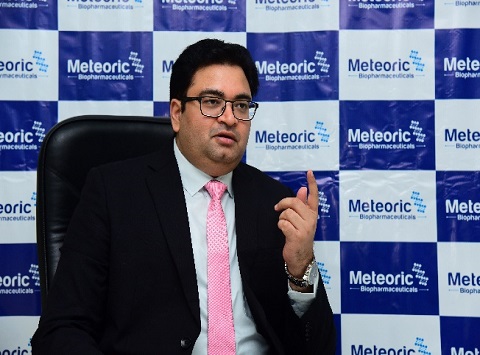After the successful completion of the Mocrobiome-2021 webinar, Endeavor Research Private Ltd successfully hosted the 4th Webinar on Webinar on Probiotics, Gut Health & Microbiome during October 22, 2021. The webinar was successful in gathering 20 eminent speakers from various reputed organizations and their paramount talks enlightened the gathering.
The pragmatic meet organized by Endeavor Research Private Ltd received generous responses from Industrialists, Academia, Talented Researchers, and the Young Student Community. Industrialists, Researchers, and Students who attended from different parts of the world made the webinar one of the most successful events from the Endeavor.
The scientific program paves a way to gather visionaries through the research talks and presentations and put forward many thought-provoking strategies.
Scientific sessions covered in the webinar i.e. Probiotics in Aquaculture, Gut-Brain Axis, Animal Probiotics and Animal Nutrition, Equipment & Technologies for Probiotics/Microbiota/Microbiome Discovery, Commercialisation and Regulation, Prebiotic interactions with the gut, Probiotics Industrial Products, Probiotics Foods, Gut Microbiota for Health & Disease, Probiotics & Prebiotics Futures, Probiotics industrial products, Probiotics & COVID-19, Pediatrics and Infant health, Microbiome R&D and Business Collaboration, Skin Microbiome, Probiotics Diet and Nutrition, Gut Health & Microbiota
The webinar was marked with the presence of renowned Speakers, Young Researchers, Students, and Business Delegates driving the one-day event into the path of success with thought-provoking keynote and oral presentations.
The webinar was initiated with the honorable presence of the Keynote forum and then Oral presentations. The list includes
Keynote Speaker

Elias Hakalehto
Finnoflag Oy - Finland
E. Elias Hakalehto, PhD, graduated from the University of Helsinki as a microbiologist in 1983. In 1995 he received the Postgraduate Diploma in Biotechnology from Canterbury and London, U.K. He is an alumnus of University College London in biochemical engineering. His R&D company Finnoflag Oy (est.1993) has carried out over 100 projects for various industries and universities. He was nominated year 2008 as an Adjunct Professor of biotechnical microbe analytics in Kuopio (nowadays University of Eastern Finland), and an Adjunct Professor for the University of Helsinki in 2016 in microbiological agroecology. Year 2015 he became the vice president of the International Society of Environmental Indicators, chairing the global 22nd ICEI conference in Helsinki 2017. Dr. Hakalehto has edited several scientific books on microbiome, hygiene maintenance, etc. His inventions include the Portable Microbe Enrichment Unit (PMEU), Bacteriological Intestinal Balance (BIB) and novel biorefineries. He is the Fellow Member of the International Society for Development and Sustainability (ISDS) (Japan).
The studies on the dissemination and effects of microbial diseases have risen in importance to the top front of medical research. This development has been boosted by the COVID-19 pandemics. However, the viruses do not possess metabolism of their own. Therefore, their interactions or threats on the human cells are somewhat different from the ones by the bacterial cells. In any case, bacteria exercise molecular communication with the host, which could support in advantageous cases, the human immune defenses. The strength and endurance of the balance within microbiome is of crucial importance for the host well-being and health. These microbiome-related factors are in key position for the immunological prowess of the human individual. This interaction could be enhanced by the selection of probiotic strains. They could provide means for the human populations to resist and recover from the pandemic effects, for instance. The beneficial bacterial strains interact with the immune system attenuating infections, inflammations and autoimmune symptoms. Consequently, it is lucrative to anticipate that some “good” bacterial strains could spread in the population, within the families etc. Is it possible to implement probiotic strains with collective protective traits into the population? Or could such strains, which we call as panbiotics, support our microbiological health? We have some preliminary evidence which is discussed in the light of contemporary health developments.
Keynote Speaker

Dr. Jeremy Everett
University of Greenwich - United Kingdom
Jeremy Everett is the Professor of Pharmaceutical Technologies at the University of Greenwich UK and Visiting Professor in the Faculty of Medicine at Imperial College. Jeremy conducts research in metabolic profiling. He is a co-discoverer of pharmacometabonomics, which is the prediction of drug effects prior to dosing via analysis of pre-dose metabolic profiles. His current work is focused on genotype – metabotype correlations in the areas of obesity and ageing and he is a co-inventor on a recently filed patent on an anti-obesogenic agent. Jeremy received his BSc and PhD in chemistry from Nottingham University, UK. He did post-doctoral studies at McMaster University and at McGill University in Canada. Jeremy is a Fellow of the Royal Society of Chemistry and a Chartered Chemist, a Member of the American Chemical Society and is an author or co-author on over 100 peer-reviewed publications and patents, with over 5,300 citations to date and an h-index of 31.
Metabolic profiling or metabonomics is an excellent methodology for phenotyping genetically modified mice. We recently used this technology in collaboration with the group of Professor Elizabeth Shephard at UCL, to investigate the metabolic phenotype of some interesting gene knockout (KO) mice. Fmo5 KO mice display reduced weight gain after 20 weeks and their gut microbiome is different from wildtype (WT) mice. Metabonomics detected a microbial compound in the urine of Fmo5 KO but not of WT mice. Subsequent treatment of WT mice with this compound mimicked some aspects of the Fmo5 KO mouse phenotype including reduced epididymal fat and improved plasma biochemistry.
This talk will overview this work and cover related examples of genotype to phenotype relationships in mice.
Keynote Speaker

Pascal RONFARD
SOLACTIS SAS - France
Founder of SOLACTIS SAS, Pascal RONFARD has positioned the company since 2013 as a leader of food and feed ingredients, active on the microbiota. This positioning has been rewarded by highly sought regulatory recognitions: two European (EFSA) and one South Korean (MFDS) official health claims. In 2015, SOLACTIS SAS has located its R&D center in the renowned Science Campus INRAe, near Paris. Since 2021, SOLACTIS SAS is part of the Greentech Group and is the Food&Feed Ingredients Division, with a product offering enlarged to micro-algae, bacteria strains and plant extracts.
Mr. Ronfard is President of the Professional Group “HEC- Agroindustry”, and member of the board of Club PAI. Mr. Ronfard is a graduate of the HEC Business School and holds a Master degree in Corporate Law, from Paris II University.
A link has been established between the gut microbiota and the host well-being and health. Therefore, development of targeted solutions, probiotics and prebiotics, appears to be a priority. This study aims to present an innovative and sustainable source of prebiotic. Indeed, production of prebiotics on an industrial scale faces several challenges, including extracting process and its yield. Microalgae are unicellular microorganisms floating in the water and were already consumed for thousands years around the world. They are easy to produce and can develop under various trophic regimes. Due to their oligosaccharides content, microalgae biomass appears as an interesting alternative. In this study, in vitro tests were carried out to assess the influence of microalgae biomass (Spirulina Platensis and Chlorella vulgaris) on probiotic bacteria growth. Results were compared to in vitro tests performed with SOLACTIS® galactofructose, a well identified prebiotic.
Keynote Speaker

J.J Lin
Imagilin Technology, LLC. - USA
J.J. Lin, Ph.D., is CEO and Chief Scientist of Imagilin Technology, LLC, and adjunct professor at Hood College in Frederick, MD. In Imagilin, Dr. Lin leads the group to develop novel, patented Probiotics- PA5051®, which is the only non-spore forming probiotics that can resist temperature at 185˚F (85˚C), stomach acid and oxygen exposure. Dr. Lin has more than 30 more years’ experiences in microbial physiology, microbial genetics, and molecular biology at academic research institutes as well as at commercial research and development division. He has published more than 50 papers and frequently presented scientific results in many international conferences. Dr. Lin leads Imagilin to have 8 issued and 8 pending patents related to compositions and applications of Pediococcus-based probiotics. Dr. Lin has years extensive experiences in collaborative research experiences with both academic and industrial organizations worldwide.
Plant-based probiotics naturally have to survive through the harsh environments such as variable temperatures (23°F to 110°F), acid rains, oxygen exposures, and antibiotics from various microorganism. Strain selections of Probiotic Pediococcus acidialctici NRRL B-50517 (PA5051®) is a probiotic isolated from the wild grass and went through series of physiological selections to resist to high temperatures up to 185°F, low pH 1.5, and high osmotic pressures, oxygen exposures, and can tolerate exposure of antibiotics. Probiotic PA5051® fermented foods, soy yogurt and freezedried soy yogurt, show that the live probiotics are detected after being treated with commercial fruit acidic juices such as lemonade, limeade, and vinegar. Viable PA5051® probiotics were detected from the fecal samples of goldfish, rats, horses, dogs, and humans. These results indicate PA5051® can survive through the stomach acids and be delivered to the human or animal gastrointestinal tracts to have probiotic health benefits. The modulation of immune responses of PA5051® on B- cells and T-cells multiplication was shown in the clinic studies of rats and horses fed with PA5051®. When the volunteers administered with PA5051® for human double-blind studies for weight management, the results showed PA5051® is not only safe for human consumption but is also useful in reducing body fat and pro-inflammatory markers. Similar results on the reduction of proinflammatory markers were observed in volunteers who underwent heavy exercises with PA5051® applications. In canine and feline, the PA5051® showed the significant effects on reduce the diseases symptoms as well as reductions in the dosages steroids and antibiotics administered in Inflammatory Bowel Diseases (IBD), IMHA (Immune Mediated Hemolytic Anemia) and Atopic Dermatitis (AD). Plant-based probiotics, PA5051 is the choice of probiotic dietary supplements that are complimentary with prescription medicines for human and animal health.
Speaker

Jonathan Tanaka
Morinaga Nutritional Foods, Inc. – USA
Jonathan has earned two undergraduate degrees, BS in Biology and BA in Cognitive Psychology from the University of California, San Diego. He also holds a MS in Biological Sciences from the California State University, Fullerton and has completed post graduate work on neuro-cognitive imaging at the University of California, Irvine School of Medicine. Jonathan is currently pursuing a Ph.D. in Clinical Sciences from the University of Central Nicaragua. His Ph.D. work focusing on systemic analyses of current regulatory policies from a clinical perspective. Professionally, he has worked in research, quality, and regulatory matters for 15+ years.
The United States of America (US) regulatory framework lays a fundamental landscape in substantiating the safety and, to an extent, the efficacy of regulated products such as probiotics and postbiotics. Interpretations of clinical efficacies and quality of products, specifically as structure-function claims or the documented attributes, may be substantiated via well-designed clinical trials and scientifically-validated methodologies and literatures. Manufacturers are increasingly commercializing products that contain probiotics for the healthy conscious consumers. One such probiotics is Bifidobacteria. However, beyond species, substantiation must occur on the strain level as well as the viability. Here, we will explore probiotic and postbiotic species on a strain level (Morinaga’s probiotics) as case studies.
Speaker

Pauliina Halimaa
Biosafe - Biological Safety Solutions Ltd – Finland
Expertise in the regulatory requirements and safety assessment of microbial products in the EU. Has extensive knowledge of EU legislation and guidelines on feed additives, food enzymes, probiotics and biopesticides. Practical know-how on whole genome sequencing and safety assessment of bacteria and yeasts based on the genome.
After gaining PhD on plant genomics and transcriptomics at the University of Eastern Finland she moved to Biosafe – Biological Safety Solutions Ltd in 2016 to develop a bioinformatics pipeline for the safety assessment of microbes used in the food chain. Biosafe Ltd now offers a comprehensive set of tests and detailed bioinformatic study reports and consultation for customers who develop novel strains or wish to place their products on the EU market. Currently responsible for the overall operations and resources of Biosafe Ltd as the CEO.
Microorganisms are widely used in food and feed applications. They may be used as starter strains in the production of fermented foods or drinks, as nutritional sources or in animal nutrition for the purpose of performing a certain beneficial function for the animal or in animal feed. Fermented foods and drinks mainly fall within the scope of the General Food law, and any food shall not be placed on the market if it is unsafe. The responsibility lies with the business operator.
Authorization of microorganisms is thus required only in specific cases and the requirements vary depending on the safety of the species. EU has adopted the so called QPS approach, which means that species with QPS status do not need to undergo a full safety assessment for authorization. Safety assessment is always based on the strain characteristics, and EFSA has made significant progress in harmonizing the requirements for the specific test and analyses of microorganisms for different purposes. As a rule, the microorganism has to be unequivocally identified, it must not carry acquired antimicrobial resistance genes or be toxigenic or virulent. More detailed requirements will be discussed.
A health claim, which is already embedded in the definition of “probiotic”, must be demonstrated. So far, EFSA has rejected probiotic health claims. Efficacy shall be demonstrated also in the case of feed additives
Speaker

Dunyaporn Trachootham
Mahidol University, Institute of Nutrition - Thailand
Dr. Dunyaporn Trachootham obtained her DDS (Dentistry) from Mahidol University, Thailand and her PhD (Biomedical Sciences: pharmacology) from University of Texas Health Sciences Center at Houston, USA. She received graduate certificate in Nutritional Sciences for Health professional from Tuft University, USA. She is an associate professor and the program director of Master of Sciences program in Toxicology and Nutrition for Food Safety at Institute of Nutrition, Mahidol University. She lectures research methodology, toxicology, nutrition, and functional food. Her area of interest is research and development of functional food for health benefits (safety and efficacy aspects). She has published various papers in peer reviewed journals and received over 6,059 citations. She also provides academic service for Thai Food and Drug Administration as an assessor of novel food, genetically modified plant, dietary supplement, food for special purposes and health claims.
Background: Probiotic yogurt containing both starter culture and additional beneficial bacteria was shown to promote bowel movement and improve mood. The present study aimed to investigate the effect of Bulgarian yogurt containing only starter culture on defecation, constipation symptoms, mood, and fecal short-chain fatty acids in healthy constipated women.
Method: A randomized, double-blinded, crossover-controlled trial was conducted in thirty-one healthy constipated women without irritable bowel diseases. After randomized into two groups, each group received an inverse order of Bulgarian yogurt (made by S. Thermophilus and L. Bulgaricus) and lactic-acidified milk curd for three weeks each with three-week washout period between interventions. Outcome included defecation frequency and fecal characteristics (Bristol stool scale), constipation symptoms (Constipation Assessment Scale and ROME IV criteria), mood (distress thermometer), and constipation-related quality of life (CRQoL questionnaire). Short-chain fatty acids were measured by GC-MS analysis of stool.
Results: Constipation symptoms (rectal pain, separate hard or lumps stool, and inability to pass stool) were relieved (p < 0.001); mood scores associated with emotional distress and constipation were reduced (p < 0.05); number of participants with fecal short-chain fatty acids (butyrate, propionate and acetate) were increased after taking Bulgarian yogurt but not the milk curd. Defecation frequency, CRQoL, and fecal characteristics were improved by both interventions.
Conclusions: The findings of this study suggested that continuous intake of Bulgarian yogurt with no additional probiotic bacteria for three weeks may relieve constipation symptoms and distress in healthy constipated women. The simultaneous increase in short-chain fatty acids suggests that the improved symptoms and mood may result from stimulation of gut-brain axis.
Speaker

Mauricio Agudelo
BIALTEC – Colombia
CE. MAURICIO AGUDELO obtained his BSc (Chemical engineering) from the University of Antioquia. He has been a serial entrepreneur for the last 10 years. He currently run a biotech startup company named Bialtec focus in redefine the animal nutrition supporting the production of animal protein antibiotic free. His areas of interest are biotechnology, precision animal nutrition, machine learning. He has published a poster and a paper in peer reviewed journals.
Background: Increased bacterial resistance has focused attention on the use of antibiotics to improve animal growth, this is driving efforts to identify promising non-antimicrobial alternatives, such as probiotics. Objective: Analyze the zootechnical response of piglets with the use of encapsulated probiotic additives compared to antibiotic additives and explore possible associations between feed conversion, diet, probiotics and the intestinal microbiota. Methods: The effect of encapsulated probiotics use at the starter stage was evaluated in a group of 111 piglets with four diets. Diet One (D1) and Diet Two (D2) contained different mixtures of encapsulated probiotics, Diet Three (D3) was supplemented with growth-promoting antibiotics, and Diet Four (D4) with copper sulfate, in addition, the microbiome of 38 pigs was sequenced, studied and linked to the FCR. Results: Significant differences (p < 0.01) in feed conversion ratio (FCR) among the diets were found when the Monte Carlo simulation was used, achieving improvements in the gross margin of up to 14% with D1–D2 compared to D3. Some operational taxonomic units (OTU) were grouped by FCR, finding potential correlations. Conclusions: This work shows the advantages of using microencapsulated probiotics to replace the antibiotics growth promoters in animal nutrition and open a door to explore new bacterial species that can be correlated with better performance in the growing of the piglets. Future work should evaluate the potential of this probiotics to improve the feed conversion on a large-scale farm and its association with the microbiome.
Speaker

Erika Gilmandinova
Kefir Lab probiotics – USA
Erika and Dario founded Kefir Lab as part of their shared vision to revolutionize the world’s perspective on having a healthy gut. Erika grow up in Moscow, Russia surrounded by family generation of doctors where she learned about the gut-brain connection and the incredible benefits probiotic Kefir has on our bodies. When she moved to North America she couldn’t find the high quality probiotic Kefir that met her expectations, where the origins of Kefir date back to 2,000 years. After experiencing drastic changes on the way she feels and performs she knew she could do much better and started to experiment making her own Kefir using the biomedical approach she learned from her father. Dario grew up in Tuscany, Italy, where he cultivated his passion about the art of real and healthy food. While in North America’s restaurant business, Dario experienced the negative effect that processed food and antibiotics have on our immune system, inflammation and overall health. Motivated by Erika’s passion in Probiotic Kefir, numerous readings and self-experiments - he felt the real difference and thrived to share it with the world!
After years of probiotic research and traveling in search of the highest quality ingredients Erika and Dario crafted the markets most functional probiotic Kefir in their Laboratory ensuring the maximum benefits for our biome. Ever since, we are honored to hear our customers transformational journeys with Kefir Lab Probiotics. We are dedicated to placing people first, delivering value, working sustainable and maintaining extremely high production standards in our Laboratory.
Recent medicine's discovery of the connection between the brain and the gut recognizes the direct influence on your digestion, mood, health and even the way you think and work. The 24 live & active cultures in our Kefir are the perfect blend to satisfy your microbiota. Probiotics will work in harmony to protect your body from bad bacteria and to promote brain functionality and longevity. The standard industrial yogurt bacteria strains are created to grow well in milk, but don’t survive inside the human gut. Yet, professional probiotic strains do find home in our microbiome. Kefir Lab is the first drinkable probiotic kefir cultured with 24 Live & Active Probiotic Strains. It’s so fresh & concentrated with the market’s highest 100 Trillion gut friendly cultures. The probiotics will work in harmony acting as a shield against the most common disease, improve digestion and promote brain functionality.
Speaker

Patrizia Contursi
University of Naples Federico II - Italy
Prof. Patrizia Contursi obtained her MSc (Biology) from the University Federico II,Napoli and her PhD (Biochemistry and Molecular Biology) from the University Federico II,Napoli. She is previously worked in the field of Biochemistry, Molecular Biology of Archaea in collaboration with University of Copenhagen. Her PhD research was based on developing of genetic systems for the archaeon Sulfolobus solfataricus. She currently lectures Biochemistry at the University of Napoli Federico II. Her area of interest is biotechnological exploitation of thermophilic microrganisms. She has published 44 papers in peer reviewed journals.
One of the most challenging food consumption issues is how to ameliorate the digestibility of foods containing some not-digestible galactosides, associated with intestinal gas and discomfort. Recently, a novel thermophilic B. coagulans strain, designed as MA-13, has been isolated from canned beans manufacturing and shown to be able to produce lactic acid from lignocellulose biomass (1,2). Interestingly, B. coagulans strains are generally recognized as safe (GRAS).
The intra and extracellular glycosyl hydrolase (GH) repertoire of MA-13 was analyzed. The most prevalent enzymatic activities were identified as a β and αgalactosidases. A full biochemical characterization of the βgalactosidase (named BcGalB), revealed that the enzyme was able to produce GOS in homo and heterocondensation reactions from artificial and natural substrates, thus proving the ability of B. coagulans MA13 to ecofriendly produce prebiotics from dairy food waste (3). Finally, to expand our understanding of the intra-strains genomic diversity of B. coagulans and to provide new insights on its genetic potential in biotechnological applications, a pangenomic study is under way.
1. Aulitto M, Fusco S, Bartolucci S, Franzén CJ, Contursi P. Bacillus coagulans MA-13: a promising thermophilic and cellulolytic strain for the production of lactic acid from lignocellulosic hydrolysate. Biotechnol Biofuels [Internet]. BioMed Central; 2017;10:210.
2. Aulitto M, Fusco S, Nickel DB, Bartolucci S, Contursi P, Franzén CJ. Seed culture pre-adaptation of Bacillus coagulans MA-13 improves lactic acid production in simultaneous saccharification and fermentation. Biotechnol Biofuels [Internet]. BioMed Central Ltd.; 2019 [cited 2020 May 7];12:45. Available from: https://biotechnologyforbiofuels.biomedcentral.com/articles/10.1186/s13068-019-1382-23.
3. Aulitto M, Strazzulli A, Sansone F, Cozzolino F, Monti M, Moracci M, et al. Prebiotic properties of Bacillus coagulans MA-13: production of galactoside hydrolyzing enzymes and characterization of the transglycosylation properties of a GH42 β-galactosidase. Microb Cell Fact [Internet]. BioMed Central; 2021;20:1–18. Available from: https://doi.org/10.1186/s12934-021-01553-y
Speaker

Dr. Martina Aulitto
University of Naples Federico II - Italy
Dr. Martina Aulitto obtained her MSc (Biology) from the University of Naples Federico II and her PhD (Biotechnology) from the University of Naples Federico II. She is previously worked in the field of molecular biology of archaeal viruses. Her PhD research was based on the exploitation of thermophilic microorganisms and their enzymes for lignocellulosic biomass conversion into value-added products. She currently works as post-doc researcher on the eco-friendly isolation of nanocellulose from agri-foods, a versatile building block for the production of food ingredients, edible coatings and flame retardants.
One of the most challenging food consumption issues is how to ameliorate the digestibility of foods containing some not-digestible galactosides, associated with intestinal gas and discomfort. Recently, a novel thermophilic B. coagulans strain, designed as MA-13, has been isolated from canned beans manufacturing and shown to be able to produce lactic acid from lignocellulose biomass (1,2). Interestingly, B. coagulans strains are generally recognized as safe (GRAS).
The intra and extracellular glycosyl hydrolase (GH) repertoire of MA-13 was analyzed. The most prevalent enzymatic activities were identified as a β and αgalactosidases. A full biochemical characterization of the βgalactosidase (named BcGalB), revealed that the enzyme was able to produce GOS in homo and heterocondensation reactions from artificial and natural substrates, thus proving the ability of B. coagulans MA13 to ecofriendly produce prebiotics from dairy food waste (3). Finally, to expand our understanding of the intra-strains genomic diversity of B. coagulans and to provide new insights on its genetic potential in biotechnological applications, a pangenomic study is under way.
1. Aulitto M, Fusco S, Bartolucci S, Franzén CJ, Contursi P. Bacillus coagulans MA-13: a promising thermophilic and cellulolytic strain for the production of lactic acid from lignocellulosic hydrolysate. Biotechnol Biofuels [Internet]. BioMed Central; 2017;10:210.
2. Aulitto M, Fusco S, Nickel DB, Bartolucci S, Contursi P, Franzén CJ. Seed culture pre-adaptation of Bacillus coagulans MA-13 improves lactic acid production in simultaneous saccharification and fermentation. Biotechnol Biofuels [Internet]. BioMed Central Ltd.; 2019 [cited 2020 May 7];12:45. Available from: https://biotechnologyforbiofuels.biomedcentral.com/articles/10.1186/s13068-019-1382-23.
3. Aulitto M, Strazzulli A, Sansone F, Cozzolino F, Monti M, Moracci M, et al. Prebiotic properties of Bacillus coagulans MA-13: production of galactoside hydrolyzing enzymes and characterization of the transglycosylation properties of a GH42 β-galactosidase. Microb Cell Fact [Internet]. BioMed Central; 2021;20:1–18. Available from: https://doi.org/10.1186/s12934-021-01553-y
Speaker

Amr T. M. Saeb
Zifo RnD Solutions-United Kingdom
Prof. Saeb earned his PhD in Molecular Phylogenetics and Population Genetics from The Ohio State University, USA, in 2006. He has more than 25 years of extensive research and teaching experience in different countries. His research interest is focused on but not limited to applied bioinformatics, molecular genetics, human genetics, complex disease genetics and evolution, diabetes genetics, bacterial pathogenomics and virulence, molecular pathology, metagenomics, microbiome, microbial genetics and host-pathogen interactions, to name a few. He delivered lectures in world-class scientific conferences held in China, the United Kingdom, Netherlands, Austria, and Spain (European Congress of Clinical Microbiology and Infectious Diseases and Welcome Genome Campus). He authored 52 total publications in international peer-review journals, mostly as first-author, and reached 444 citations and counting. An educator and researcher skilled in designing learning programs, conducting research projects, and enriching lives.
Diabetic foot ulcer is a significant complication for diabetic patients. It is the most common cause of both hospitalization and amputations in Diabetics. Many factors may affect wound healing, namely, microbial density, microorganisms, microbial synergy, the host immune response, and infected tissue quality. Methodology: This study used a cross-sectional design. We assessed 38 Subjects with DFUs, 23 neuroischaimic, and 15 neuropathic, for microbiota colonizing the DFU utilizing traditional cultures and 16S gene sequencing methods. All the relevant clinical factors were collected. Wound swabs were collected for both traditional microbiological analysis, direct swab (DSM), and cultured (CM) microbiome analysis. DNA isolation and 16SrRNA hypervariable regions were amplified. DNA sequencing was performed using the Ion proton to characterize each microbiome in the samples. Bioinformatics analysis was performed using IonReporter Software, statistical analysis, and diversity indices were computed with vegan R-package, Past2, and SPSS 22 software. Results: Traditional microbiological method failed to compete with either tested microbiome method in reflecting the real microbial situation inside the DFU in all 38 cases. The traditional microbiological method was able to detect a maximum of one or two pathogens, and, in some cases, no pathogen was detected. The total number of the observed species was 176. The number of identified species was higher in the cultured microbiome (155) than the direct swab microbiome (136). Diversity analysis indicated that biological diversity is higher in the cultured microbiome compared with the direct swab microbiome. The Shannon H index was 2.75 for the cultured microbiome and 2.63 for the direct swab microbiome. We observed some differences in the major bacterial taxa amongst neuroischaimic and neuropathic DFU microbiomes. However, all diversity indices were not significantly different amongst the two types of ulcer microbiomes. Neither Cluster analysis nor Principal component analysis showed apparent clustering or pattern amongst the two types of ulcers. Conclusions: cultured microbiome is superior to both the traditional method and direct swab microbiome. Generally, the Neuroischaimic group showed higher values for the tested diversity indices than the Neuroischaimic group. Neither Cluster Analysis nor Principal Component Analysis showed apparent clustering or pattern amongst the two types of ulcers.
Speaker

Katrine Whiteson
Assistant Professor, University of California Irvine, Co-Director, UCI Microbiome Center, USA
Dr. Katrine Whiteson is an Assistant Professor at University of California Irvine and the co-Director of the UCI Microbiome Center She studied Biochemistry at UC Berkeley (BA, 2000) and University of Chicago (PhD, 2007). She first had the opportunity to study human-associated microbes at the University of Geneva Hospitals in 2008. Her lab at UCI studies the human microbiome in health and disease. This has them hunting for bacteria, fungi and viruses in feces, sewage, sputum and other well-loved samples - the students are brave! She will present findings from collaborations with Professors Jen Martiny and Julia Sewell to run a high fiber diet intervention at UC Irvine, and with Cal State Fullerton Anthropologist John Patton to study microbiomes from Conambo, Ecuador. Their favorite study designs are longitudinal, and they use metabolomics and sequencing along with in vitro culturing and experimental evolution to study human microbiomes.
As access to processed foods has increased in the past century, intake of dietary fiber has decreased precipitously, leaving our colons devoid of important substrates for the gut microbiome. We studied saliva, Chicha and fecal microbiomes from 28 households in the Ecuadorian Amazon and found them to be very enriched in plant fiber degrading microbes and genes. We ran a fiber-rich dietary intervention in the context of a course-based undergraduate research experience (CURE) with 20 undergraduate participants and studied the impact on their microbiomes
Speaker

Gaurav Kaushik
Meteoric Biopharmaceuticals Private Limited - India
In 2006, Gaurav Kaushik, a young and dynamic first-generation entrepreneur, set out to author a legacy. Today, under his leadership Meteoric Biopharmaceuticals Pvt. Ltd., with over 100 products across Enzymes, Probiotics, Nutraceuticals, Finished Formulations & Animal Healthcare, is a leading name in the biopharma landscape across the globe.
A gold medalist in Biotechnology and an astute businessman, Gaurav has been awarded the Rastriya Udyog Ratan Award by the Council of Economic Growth & Research. He is also the recipient of the Indian Leadership Award for Industrial Development by the All-India Achievers Foundation.
More recently, under his leadership, Meteoric Biopharma has been recognized as one of the 25 Most Valuable Biopharma Companies by CEO Magazine for its uncompromised dedication to quality and investment in the latest technology. Mr. Kaushik himself was recognized amongst the 101 Most Fabulous Health Care Leaders by ET Rise & World Health & Wellness Congress.
The connection between the brain and gut is known to affect human emotion, motivation, and higher cognitive function, in addition to maintaining homeostasis of the gastrointestinal tract. This complex interaction is referred to as the brain–gut axis (BGA). Central cognitive processes including emotion, cognition, and pain have been linked with specific brain regions on functional neuroimaging modalities and these systems have been found to communicate in dynamic ways with the GI system. With descending input from cognitive and emotional centers, the link between psychological distress and functional gastrointestinal symptoms is based on dysfunction in the brain-gut-axis. One of the brain regions key to the Brain Gut Microbiome Axis (BGMA) is the emotional arousal network (EAN), which functions to link stimulus appraisal areas (salience network) and autonomic nervous system output to peripheral targets, including the digestive system. The gut microbiota communicates with the gut connectome, the network of interacting cell types in the gut that include neuronal, glial, endocrine, and immune cells via microbial metabolites, while changes in gut function can modulate gut microbial behaviour. The brain connectome, the multiple interconnected structural networks of the central nervous system generates and regulates autonomic nervous system influences that alter gut microbial composition and function indirectly by modulating the microbial environment in the gut. The gut microbiota can communicate to the brain indirectly via gut-derived molecules acting on afferent vagal and/or spinal nerve endings, or directly via microbe-generated signals. Alterations in the gain of these bidirectional interactions in response to perturbations such as psychosocial or gut-directed (eg, diet, medication, infection) stress can alter the stability and behaviour of this system, manifesting as brain-gut disorders.
Speaker

Heather Holmes
Eco Balanced Technologies, Inc. - USA
Heather Holmes is an educator and consultant on biofilm and the role of soil-based probiotics in creating healthy personal spaces. She spent 20 years in sales and management with medical device and equipment companies, such as Stryker, STERIS and Medtronic. During seven of these years, Heather worked in sterilization and regularly consulted with microbiologist and epidemiologists. Heather’s expertise has been sought after by Functional Medicine and Integrative Practitioners to assist them in developing soil-based probiotic protocols for various disease states and conditions, such as Marcons, Lyme Disease, Morgellons, Eczema, Psoriasis, Wound Care, Acne, Halitosis, IBS and many others.
The use of probiotics to benefit the gut is well documented. Probiotics also play a pivotal role in our personal environments, as well. You could say that the internal use and external use of probiotics, when used in combination, are the perfect way to create a stronger immune system. Their roles are complementary and equally important. Unfortunately, there is little discussion by health professionals and practitioners about the importance and impact the external environment has on the gut. The direct correlation of the soil-based probiotics used in personal spaces for cleaning of surfaces, air, teeth and skin must be considered a critical component of an individual’s health and wellness regime. It is important to think in terms of the gut biome being symbiotic with the biome of an individual’s personal environment. We must take into account the barrage of environmental toxics, specifically decades of overuse of chemical disinfectants and antibacterials, in our personal spaces. COVID cleaning measures have only increased the strain on the individual’s personal biome, both internally and externally, and have increased the virulence of certain superbugs and fungus.
These chemical cleaners have contributed to the formation of Biofilm that is directly linked to nearly 80% of all infection and disease. The destruction and elimination of good, beneficial bacteria has made it easy for bad bacteria to form deadly biofilms, contributing to the dysbiosis of the gut and the environment. As a result, auto-immune disease is affecting nearly 70% of the population and climbing. Therefore, the correlation of autoimmune disease and deadly biofilms can no longer be ignored.
Speaker

Di Pierro
PharmExtracta S.p.A - Switzerland
Francesco Di Pierro (PhD in Immunology) carried out his career as a researcher at the Institute of Microbiology in Turin. In the following years he worked in many Research Units in Italy including Italfarmaco, Indena and SIIT Pharmaceuticals. He is currently Scientific Director in Velleja Research and My Microbiota (both in Piacenza, Italy), Head of the Microbiome Unit at the Poliambulanza Hospital (Brescia, Italy), Contract professor at UNICAM University (Camerino, Italy) and Editor-in-Chief for Nutrafoods (a journal devoted to nutritional supplement science).
He is author of hundreds of scientific papers with a personal IF > 500.
The Community State Type I (CST I), characterised by L. crispatus dominance, is the one that best stabilises and protects the vaginal environment. For this reason, the correlation between the dominance of L. crispatus in the vaginal environment and the possible prevention/clearance of HPV infection is currently under spotlight. This is due to the fact that L. crispatus is able to restore the altered vaginal microbiota, which therefore favored HPV infection, by re-establishing adequate pH and mucosal integrity in the vaginal environment. Metanalysis (Norenhag, 2019) showed that women with CST I were 3 to 5-fold less prone to HPV infections than other women. starting from this premise, a pilot study using L. crispatus M247 confirmed a strong correlation between the use of this bacterial strain and the clearance of HR-HPV.
Speaker

Mithilesh Jaiswal
Tropilite Foods Pvt Ltd - India
Dr. Mithilesh Jaiswal obtained his MSc (Bioscience) and PhD ( Microbiology) from the University of Jabalpur ( India). He is currently working on Probiotic cultures and development of synbiotic products for various Human and animal application. His Ph.D research was based on the Mycoherbicidal potential of different fungi against the biological control of hazardous weed like Parthenium . His area of interest is Probiotics, Starter cultures and Biofertilizers. He has published various papers in peer reviewed journals.
Probiotics are live microorganism which provides health benefits to the host. Therapeutic potential of probiotic cultures and synbiotic products are well established against the several health problems. Probiotic bacteria and yeast have become more popular during the last three decades as a result of the continuously expanding scientific evidence pointing to their beneficial effects on human and animal health. These are act as natural antibiotics in the gut and helps to suppress the growth of pathogenic microorganisms. Eating of unhealthier foods with chemical preservative, drinking unsafe water, imbalanced diet and bad routine lifestyle effects our immune system badly. Supplementation with probiotic and synbiotics has shown promising results against various enteric pathogens due to their unique ability to compete with pathogenic microbiota for adhesion sites to alienate pathogens and also maintaining the gastrointestinal microbial balance. Nowadays, probiotics are helpful in many ways such as boosting the immune system, inhibition of pathogenic organism, prevention of cancer, reduction of inflammatory bowel disease, reducing cholesterol level and diarrhea. In animals, probiotics improved feed conversion for the target species and reduces the mortality rate. Due to high beneficial impact on human as well as animal health, these microorganisms have been used by various Foods, Pharma and Feed industries in their products. As a result awareness and demand of these probiotics products increases day by day. Hence, our objective is to understand the current status of the probiotics and its possible beneficial impact on human and animal health for better lifestyle